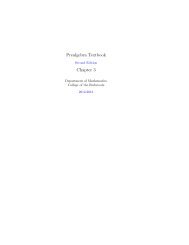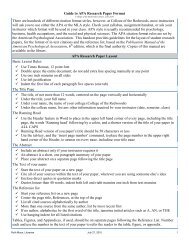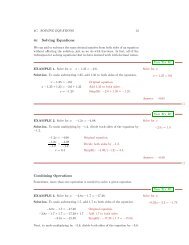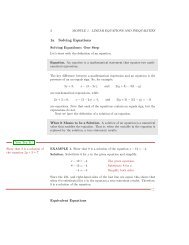Math 376 Prealgebra Textbook
Math 376 Prealgebra Textbook
Math 376 Prealgebra Textbook
You also want an ePaper? Increase the reach of your titles
YUMPU automatically turns print PDFs into web optimized ePapers that Google loves.
8 MODULE 3. EQUATIONS<br />
3b<br />
Solving Systems of Two Equations Algebraically<br />
Solving Systems by Substitution<br />
In this section we introduce an algebraic technique for solving systems of two<br />
equations in two unknowns called the substitution method.<br />
Substitution method.<br />
steps:<br />
The substitution method involves two consecutive<br />
1. Solve either equation for either variable.<br />
2. Substitute the result from step one into the other equation.<br />
You Try It!<br />
EXAMPLE 1. Solve the following system of equations:<br />
2x − 5y = −8 (3.5)<br />
y =3x − 1 (3.6)<br />
Solution: Equation (3.30) is already solved for y. Substitute equation (3.30)<br />
into equation (3.29).<br />
Now solve for x.<br />
2x − 5y = −8 Equation (3.29).<br />
2x − 5(3x − 1) = −8 Substitute (3.30) in (3.29).<br />
2x − 15x +5=−8 Distribute −5.<br />
−13x +5=−8<br />
−13x = −13<br />
Simplify.<br />
Subtract 5 from both sides.<br />
x =1 Divide both sides by −13.<br />
Substitute x = 1 in equation (3.30), then solve for y.<br />
y =3x − 1 Equation (3.30).<br />
y =3(1)− 1 Substitute 1 for x.<br />
y =2<br />
Simplify.<br />
Hence, (x, y) =(1, 2) is the solution of the system.<br />
Check: To show that the solution (x, y) =(1, 2) is a solution of the system,<br />
we need to show that (x, y) =(1, 2) satisfies both equations (3.29) and(3.30).
3B. SOLVING SYSTEMS OF TWO EQUATIONS ALGEBRAICALLY 9<br />
Substitute (x, y) =(1, 2) in equation<br />
(3.29):<br />
2x − 5y = −8<br />
2(1) − 5(2) = −8<br />
2 − 10 = −8<br />
−8 =−8<br />
Thus, (1, 2) satisfies equation<br />
(3.29).<br />
Substitute (x, y) =(1, 2) in equation<br />
(3.30):<br />
y =3x − 1<br />
2=3(1)− 1<br />
2=3− 1<br />
2=2<br />
Thus, (1, 2) satisfies equation<br />
(3.30).<br />
□<br />
You Try It!<br />
EXAMPLE 2. Solve the following system of equations:<br />
5x − 2y = 12 (3.7)<br />
4x + y = 6 (3.8)<br />
Solution: The first step is to solve either equation for either variable. This<br />
means that we can solve the first equation for x or y, but it also means that we<br />
could first solve the second equation for x or y. Of these four possible choices,<br />
solving equation (3.32) fory seems the easiest way to start.<br />
4x + y =6 Equation (3.32).<br />
y =6− 4x<br />
Subtract 4x from both sides.<br />
Next, substitute y =6− 4x for y in equation (3.31).<br />
5x − 2y =12 Equation (3.31).<br />
5x − 2(6 − 4x) =12 Substitute y =6− 4x for y.<br />
5x − 12 + 8x =12 Distribute −2.<br />
13x − 12 = 12<br />
13x =24<br />
x = 24<br />
13<br />
Simplify.<br />
Add 12 to both sides.<br />
Divide both sides by 13.<br />
Finally, to find the y-value, substitute x =24/13 into the equation y =
10 MODULE 3. EQUATIONS<br />
6 − 4x (you can also substitute x =24/13 into equation (3.31) or(3.32)).<br />
y =6− 4x<br />
( ) 24<br />
y =6− 4<br />
13<br />
y = 78<br />
13 − 96<br />
13<br />
y = − 18<br />
13<br />
Substitute x =24/13 in y =6− 4x.<br />
Multiply, then make equivalent fractions.<br />
Simplify.<br />
Hence, (x, y) =(24/13, −18/13) is the solution of the system.<br />
□<br />
You Try It!<br />
EXAMPLE 3. Solve the following system of equations:<br />
3x − 2y = 6 (3.9)<br />
4x +5y = 20 (3.10)<br />
Solution: Dividing by 2 gives easier fractions to deal with than dividing by<br />
3, 4, or 5, so let’s start by solving equation (3.33) fory.<br />
3x − 2y =6 Equation (3.33).<br />
−2y =6− 3x<br />
y = 6 − 3x<br />
−2<br />
y = −3+ 3 2 x<br />
Substitute y = −3+ 3 2x for y in equation (3.34).<br />
Subtract 3x from both sides.<br />
Divide both sides by −2.<br />
Divide both terms by −2<br />
using distributive property.<br />
4x +5y =20 Equation (3.34).<br />
4x +5<br />
(−3+ 3 )<br />
2 x =20 Substitute −3+ 3 x for y.<br />
2<br />
4x − 15 + 15 x =20 Distribute the 5.<br />
2<br />
8x − 30 + 15x =40 Clear fractions by multiplying<br />
both sides by 2.<br />
23x =70<br />
x = 70<br />
23<br />
Simplify. Add 30 to both sides.<br />
Divide both sides by 23.
3B. SOLVING SYSTEMS OF TWO EQUATIONS ALGEBRAICALLY 11<br />
To find y, substitute x =70/23 for x into equation y = −3+ 3 2 x.<br />
y = −3+ 3 2 x<br />
y = −3+ 3 ( ) 70<br />
Substitute 70/23 for x.<br />
2 23<br />
y = − 69<br />
23 + 105 Multiply. Make equivalent fractions.<br />
23<br />
y = 36<br />
Simplify.<br />
23<br />
Hence, (x, y) =(70/23, 36/23) is the solution of the system.<br />
□<br />
Exceptional Cases Revisited<br />
It is entirely possible that you might apply the substitution method to asystem<br />
of equations that either have an infinite number of solutions or no solutions at<br />
all. Let’s see what happens should you do that.<br />
You Try It!<br />
EXAMPLE 4. Solve the following system of equations:<br />
2x +3y = 6 (3.11)<br />
y = − 2 3 x + 4 (3.12)<br />
Solution: Equation (3.36) is already solved for y, so let’s substitute y =<br />
− 2 3x +4fory in equation 3.35.<br />
2x +3y =6 Equation (3.35).<br />
2x +3<br />
(− 2 )<br />
3 x +4 =6 Substitute − 2 3 x +4fory.<br />
2x − 2x +12=6 Distribute the 3.<br />
12 = 6 Simplify.<br />
Goodness! What happened to the x How are we supposed to solve for x in<br />
this situation<br />
However, the resulting statement, 12 = 6, is false, no matter what we use<br />
for x and y. This should give us a clue that there are no solutions. Perhaps we<br />
are dealing with parallel lines<br />
Let’s solve equation (3.35) to determine the situation.<br />
2x +3y =6 Equation (3.35).<br />
3y = −2x +6<br />
Subtract 2x from both sides.<br />
y = − 2 x +2 Divide both sides by 3.<br />
3
12 MODULE 3. EQUATIONS<br />
Thus, our system is equivalent to the following two equations.<br />
y = − 2 3 x + 2 (3.13)<br />
y = − 2 3 x + 4 (3.14)<br />
These lines have the same slope −2/3, but different y-intercepts (one has y-<br />
intercept (0, 2), the other has y-intercept (0, 4)). Hence, these are two distinct<br />
parallel lines and the system has no solution.<br />
□<br />
You Try It!<br />
EXAMPLE 5. Solve the following system of equations:<br />
2x − 6y = −8 (3.15)<br />
x =3y − 4 (3.16)<br />
Solution: Equation (3.40) is already solved for x, so let’s substitute x =3y−4<br />
for x in equation (3.39).<br />
2x − 6y = −8 Equation (3.39).<br />
2(3y − 4) − 6y = −8 Substitute 3y − 4forx.<br />
6y − 8 − 6y = −8 Distribute the 2.<br />
−8 =−8<br />
Simplify.<br />
Goodness! What happened to the x How are we supposed to solve for x in<br />
this situation However, note that the resulting statement, −8 =−8, is a true<br />
statement this time. Perhaps this is an indication that we are dealing with the<br />
same line<br />
Let’s put both equations (3.39) and(3.40) into slope-intercept form so that<br />
we can compare them.<br />
Solve equation (3.39) fory:<br />
2x − 6y = −8<br />
−6y = −2x − 8<br />
y = −2x − 8<br />
−6<br />
y = 1 3 x + 4 3<br />
Solve equation (3.40) fory:<br />
x =3y − 4<br />
x +4=3y<br />
x +4<br />
= y<br />
3<br />
y = 1 3 x + 4 3<br />
Hence, the lines have the same slope and the same y-intercept and they are<br />
exactly the same lines. Thus, there are an infinite number of solutions. Indeed,
3B. SOLVING SYSTEMS OF TWO EQUATIONS ALGEBRAICALLY 13<br />
any point on either line is a solution. Examples of solution points are (0, 4/3),<br />
(−4, 0), and (−1, 1).<br />
□<br />
Tip. When you substitute one equation into another and the variable disappears,<br />
consider:<br />
1. If the resulting statement is false, suspect that the lines are parallel lines<br />
and there is no solution.<br />
2. If the resulting statement is true, suspect that you have the same lines<br />
and there are an infinite number of solutions.<br />
Solving Systems by Elimination<br />
When both equations of a system are in standard form Ax + By = C, thena<br />
process called elimination is the best procedure to use to find the solution of<br />
the system. Elimination is based on two simple ideas, the first of which should<br />
be familiar.<br />
1. Multiplying both sides of an equation by a non-zero number does not<br />
change its solutions. Thus, the equation<br />
x +3y = 7 (3.17)<br />
will have the same solutions (it’s the same line) as the equation obtained<br />
by multiplying equation (3.17) by2.<br />
2x +6y = 14 (3.18)<br />
2. Adding two true equations produces another true equation. For example,<br />
consider what happens when you add 4 = 4 to 5 = 5.<br />
4 = 4<br />
5 = 5<br />
9 = 9<br />
Even more importantly, consider what happens when you add two equations<br />
that have (2, 1) as a solution. The result is a third equation whose<br />
graph also passes through the solution.
14 MODULE 3. EQUATIONS<br />
x + y =3<br />
5<br />
y<br />
x + y = 3<br />
x − y = 1<br />
2x = 4<br />
x = 2<br />
−5 5<br />
x<br />
x − y =1<br />
−5<br />
x =2<br />
Elimination. Adding a multiple of an equation to a second equation produces<br />
and equation that passes through the same solution as the first two equations.<br />
Let’s use these ideas to solve a system of equations.
3B. SOLVING SYSTEMS OF TWO EQUATIONS ALGEBRAICALLY 15<br />
You Try It!<br />
EXAMPLE 6. Solve the following system of equations.<br />
x +2y = −5 (3.19)<br />
2x − y = −5 (3.20)<br />
Solution: Our focus will be on eliminating the variable x. We note that if we<br />
multiply equation (3.19) by−2, then add the result to equation (3.20), the x<br />
terms will be eliminated.<br />
−2x − 4y = 10 Multiply equation (3.19) by−2.<br />
2x − y = −5 Equation (3.20).<br />
− 5y = 5 Add the equations.<br />
Thus, y = −1.<br />
To find the corresponding value of x, substitute y = −1 in equation (3.19)<br />
(or equation (3.20)) and solve for x.<br />
x +2y = −5 Equation (3.19)<br />
x +2(−1) = −5 Substitute y = −1.<br />
x = −3 Solve for x.<br />
Check: To check, we need to show that the point (x, y) =(−3, 1) satisfies<br />
both equations.<br />
Substitute (x, y) = (−3, −1) into<br />
equation (3.19).<br />
x +2y = −5<br />
−3+2(−1) = −5<br />
−5 =−5<br />
Substitute (x, y) = (−3, −1) into<br />
equation (3.20).<br />
2x − y = −5<br />
2(−3) − (−1) = −5<br />
−5 =−5<br />
Thus, the point (x, y) =(−3, −1) satisfies both equations and is therefore the<br />
solution of the system.<br />
□<br />
To show that you have the option of which variable you choose to eliminate,<br />
let’s try Example 6 a second time, this time eliminating y instead of x.<br />
You Try It!<br />
EXAMPLE 7. Solve the following system of equations.<br />
x +2y = −5 (3.21)<br />
2x − y = −5 (3.22)
16 MODULE 3. EQUATIONS<br />
Solution: This time we focus on eliminating the variable y. We note that if<br />
we multiply equation (3.22) by 2, then add the result to equation (3.21), the y<br />
terms will be eliminated.<br />
x + 2y = −5 Equation (3.21).<br />
4x − 2y = −10 Multiply equation (3.22) by2.<br />
5x = −15 Add the equations.<br />
Thus, x = −3.<br />
To find the corresponding value of y, substitute x = −3 in equation (3.21)<br />
(or equation (3.22)) and solve for y.<br />
x +2y = −5 Equation (3.21)<br />
−3+2y = −5 Substitute x = −3.<br />
2y = −2<br />
Add 3 to both sides.<br />
y = −1 Divide both sides by 2.<br />
Hence, (x, y) =(−3, −1), just as in Example 6, is the solution of the system.<br />
Sometimes the elimination method requires a process similar to that of<br />
finding a common denominator.<br />
□<br />
You Try It!<br />
EXAMPLE 8. Solve the following system of equations.<br />
3x +4y = 12 (3.23)<br />
2x − 5y = 10 (3.24)<br />
Solution: Let’s focus on eliminating the x-terms. Note that if we multiply<br />
equation (3.23) by 2, then multiply equation (3.24) by−3, the x-terms will<br />
be eliminated when we add the resulting equations. Note that 6 is the least<br />
common multiple of 3 and 2.<br />
6x + 8y = 24 Multiply equation (3.23) by2.<br />
−6x + 15y = −30 Multiply equation (3.24) by−3.<br />
23y = −6 Add the equations.<br />
Hence, y = −6/23.<br />
At this point, we could substitute y = −6/23 in either equation, then solve<br />
the result for x. However, working with y = −6/23 is a bit daunting, particularly<br />
in the light of elimination being easier. So let’s use elimination again,<br />
this time focusing on eliminating y. Similarly, if we multiply equation (3.23)<br />
by 5, then multiply equation (3.24) by 4, when we add the results, the y-terms<br />
will be eliminated.
3B. SOLVING SYSTEMS OF TWO EQUATIONS ALGEBRAICALLY 17<br />
15x + 20y = 60 Multiply equation (3.23) by5.<br />
8x − 20y = 40 Multiply equation (3.24) by4.<br />
23x = 100 Add the equations.<br />
Thus, x =100/23, and the system of the system is (x, y) =(100/23, −6/23).<br />
□<br />
Exceptional Cases<br />
In the previous section, we saw that if the substitution method led to a false<br />
statement, we should suspect that we have parallel lines. The same thing can<br />
happen with the elimination method of this section.<br />
You Try It!<br />
EXAMPLE 9. Solve the following system of equations.<br />
x + y = 3 (3.25)<br />
2x +2y = −6 (3.26)<br />
Solution: Let’s focus on eliminating the x-terms. Note that if we multiply<br />
equation (3.25)by−2, the x-terms will be eliminated when we add the resulting<br />
equations.<br />
−2x − 2y = −6 Multiply equation (3.25) by−2.<br />
2x + 2y = −6 Equation (3.26).<br />
0 = −12 Add the equations.<br />
Because of our experience with this solving this exceptional case with substitution,<br />
the fact that both variables have disappeared should not be completely<br />
surprising. Note that this last statement is false, regardless of the values of x<br />
and y. Hence, the system has no solution.<br />
Indeed, if we find the intercepts of each equation and plot them, then we<br />
can easily see that the lines of this system are parallel (see Figure 3.8). Parallel<br />
lines never intersect, so the system has no solutions.<br />
□<br />
You Try It!<br />
EXAMPLE 10. Solve the following system of equations.<br />
x − 7y = 4 (3.27)<br />
−3x +21y = −12 (3.28)
18 MODULE 3. EQUATIONS<br />
y<br />
5<br />
(0, 3)<br />
(3, 0)<br />
−5 (−3, 0)<br />
5<br />
x<br />
x + y =3<br />
(0, −3)<br />
−5<br />
2x +2y = −6<br />
Figure 3.8: The lines x + y =3and2x +2y = −6 are parallel.<br />
Solution: We might recognize that the equations 3.27 and (3.28) are identical.<br />
But it’s also conceivable that we don’t see that right away and begin the<br />
elimination method. Let’s multiply the first equation by 3, then add. This will<br />
eliminate the x-terms.<br />
3x − 21y = 12 Multiply equation (3.27) by3.<br />
−3x + 21y = −12 Equation (3.28).<br />
0 = 0 Add the equations.<br />
Again, all of the variables have disappeared! However, this time the last statement<br />
is true, regardless of the values of x and y.<br />
Notice that if we multiply equation (3.27) by−3, then we have two identical<br />
equations.<br />
−3x + 21y = −12 Multiply equation (3.27) by3.<br />
−3x + 21y = −12 Equation (3.28).<br />
The equations are identical! Hence, there are an infinite number of points of<br />
intersection. Indeed, any point on either line is a solution. Example points of<br />
solution are (4, 0), (0, −4/7), and (18, 2).<br />
□
3B. SOLVING SYSTEMS OF TWO EQUATIONS ALGEBRAICALLY 19<br />
Solving Systems by Substitution<br />
In this section we introduce an algebraic technique for solving systems of two<br />
equations in two unknowns called the substitution method.<br />
Substitution method.<br />
steps:<br />
The substitution method involves two consecutive<br />
1. Solve either equation for either variable.<br />
2. Substitute the result from step one into the other equation.<br />
You Try It!<br />
EXAMPLE 11. Solve the following system of equations:<br />
2x − 5y = −8 (3.29)<br />
y =3x − 1 (3.30)<br />
Solution: Equation (3.30) is already solved for y. Substitute equation (3.30)<br />
into equation (3.29).<br />
Now solve for x.<br />
2x − 5y = −8 Equation (3.29).<br />
2x − 5(3x − 1) = −8 Substitute (3.30) in (3.29).<br />
2x − 15x +5=−8 Distribute −5.<br />
−13x +5=−8<br />
−13x = −13<br />
Simplify.<br />
Subtract 5 from both sides.<br />
x =1 Divide both sides by −13.<br />
Substitute x = 1 in equation (3.30), then solve for y.<br />
y =3x − 1 Equation (3.30).<br />
y =3(1)− 1 Substitute 1 for x.<br />
y =2<br />
Simplify.<br />
Hence, (x, y) =(1, 2) is the solution of the system.<br />
Check: To show that the solution (x, y) =(1, 2) is a solution of the system,<br />
we need to show that (x, y) =(1, 2) satisfies both equations (3.29) and(3.30).
20 MODULE 3. EQUATIONS<br />
Substitute (x, y) =(1, 2) in equation<br />
(3.29):<br />
2x − 5y = −8<br />
2(1) − 5(2) = −8<br />
2 − 10 = −8<br />
−8 =−8<br />
Thus, (1, 2) satisfies equation<br />
(3.29).<br />
Substitute (x, y) =(1, 2) in equation<br />
(3.30):<br />
y =3x − 1<br />
2=3(1)− 1<br />
2=3− 1<br />
2=2<br />
Thus, (1, 2) satisfies equation<br />
(3.30).<br />
□<br />
You Try It!<br />
EXAMPLE 12. Solve the following system of equations:<br />
5x − 2y = 12 (3.31)<br />
4x + y = 6 (3.32)<br />
Solution: The first step is to solve either equation for either variable. This<br />
means that we can solve the first equation for x or y, but it also means that we<br />
could first solve the second equation for x or y. Of these four possible choices,<br />
solving equation (3.32) fory seems the easiest way to start.<br />
4x + y =6 Equation (3.32).<br />
y =6− 4x<br />
Subtract 4x from both sides.<br />
Next, substitute y =6− 4x for y in equation (3.31).<br />
5x − 2y =12 Equation (3.31).<br />
5x − 2(6 − 4x) =12 Substitute y =6− 4x for y.<br />
5x − 12 + 8x =12 Distribute −2.<br />
13x − 12 = 12<br />
13x =24<br />
x = 24<br />
13<br />
Simplify.<br />
Add 12 to both sides.<br />
Divide both sides by 13.<br />
Finally, to find the y-value, substitute x =24/13 into the equation y =6− 4x
3B. SOLVING SYSTEMS OF TWO EQUATIONS ALGEBRAICALLY 21<br />
(you can also substitute x =24/13 into equation (3.31) or(3.32)).<br />
y =6− 4x<br />
( ) 24<br />
y =6− 4<br />
13<br />
y = 78<br />
13 − 96<br />
13<br />
y = − 18<br />
13<br />
Substitute x =24/13 in y =6− 4x.<br />
Multiply, then make equivalent fractions.<br />
Simplify.<br />
Hence, (x, y) =(24/13, −18/13) is the solution of the system.<br />
□<br />
You Try It!<br />
EXAMPLE 13. Solve the following system of equations:<br />
3x − 2y = 6 (3.33)<br />
4x +5y = 20 (3.34)<br />
Solution: Dividing by 2 gives easier fractions to deal with than dividing by<br />
3, 4, or 5, so let’s start by solving equation (3.33) fory.<br />
3x − 2y =6 Equation (3.33).<br />
−2y =6− 3x<br />
y = 6 − 3x<br />
−2<br />
y = −3+ 3 2 x<br />
Substitute y = −3+ 3 2x for y in equation (3.34).<br />
Subtract 3x from both sides.<br />
Divide both sides by −2.<br />
Divide both terms by −2<br />
using distributive property.<br />
4x +5y =20 Equation (3.34).<br />
4x +5<br />
(−3+ 3 )<br />
2 x =20 Substitute −3+ 3 x for y.<br />
2<br />
4x − 15 + 15 x =20 Distribute the 5.<br />
2<br />
8x − 30 + 15x =40 Clear fractions by multiplying<br />
both sides by 2.<br />
23x =70<br />
x = 70<br />
23<br />
Simplify. Add 30 to both sides.<br />
Divide both sides by 23.
22 MODULE 3. EQUATIONS<br />
To find y, substitute x =70/23 for x into equation y = −3+ 3 2 x.<br />
y = −3+ 3 2 x<br />
y = −3+ 3 ( ) 70<br />
Substitute 70/23 for x.<br />
2 23<br />
y = − 69<br />
23 + 105 Multiply. Make equivalent fractions.<br />
23<br />
y = 36<br />
Simplify.<br />
23<br />
Hence, (x, y) =(70/23, 36/23) is the solution of the system.<br />
□<br />
Exceptional Cases Revisited<br />
It is entirely possible that you might apply the substitution method to asystem<br />
of equations that either have an infinite number of solutions or no solutions at<br />
all. Let’s see what happens should you do that.<br />
You Try It!<br />
EXAMPLE 14. Solve the following system of equations:<br />
2x +3y = 6 (3.35)<br />
y = − 2 3 x + 4 (3.36)<br />
Solution: Equation (3.36) is already solved for y, so let’s substitute y =<br />
− 2 3x +4fory in equation 3.35.<br />
2x +3y =6 Equation (3.35).<br />
2x +3<br />
(− 2 )<br />
3 x +4 =6 Substitute − 2 3 x +4fory.<br />
2x − 2x +12=6 Distribute the 3.<br />
12 = 6 Simplify.<br />
Goodness! What happened to the x How are we supposed to solve for x in<br />
this situation<br />
However, the resulting statement, 12 = 6, is false, no matter what we use<br />
for x and y. This should give us a clue that there are no solutions. Perhaps we<br />
are dealing with parallel lines<br />
Let’s solve equation (3.35) to determine the situation.<br />
2x +3y =6 Equation (3.35).<br />
3y = −2x +6<br />
Subtract 2x from both sides.<br />
y = − 2 x +2 Divide both sides by 3.<br />
3
3B. SOLVING SYSTEMS OF TWO EQUATIONS ALGEBRAICALLY 23<br />
Thus, our system is equivalent to the following two equations.<br />
y = − 2 3 x + 2 (3.37)<br />
y = − 2 3 x + 4 (3.38)<br />
These lines have the same slope −2/3, but different y-intercepts (one has y-<br />
intercept (0, 2), the other has y-intercept (0, 4)). Hence, these are two distinct<br />
parallel lines and the system has no solution.<br />
□<br />
You Try It!<br />
EXAMPLE 15. Solve the following system of equations:<br />
2x − 6y = −8 (3.39)<br />
x =3y − 4 (3.40)<br />
Solution: Equation (3.40) is already solved for x, so let’s substitute x =3y−4<br />
for x in equation (3.39).<br />
2x − 6y = −8 Equation (3.39).<br />
2(3y − 4) − 6y = −8 Substitute 3y − 4forx.<br />
6y − 8 − 6y = −8 Distribute the 2.<br />
−8 =−8<br />
Simplify.<br />
Goodness! What happened to the x How are we supposed to solve for x in<br />
this situation However, note that the resulting statement, −8 =−8, is a true<br />
statement this time. Perhaps this is an indication that we are dealing with the<br />
same line<br />
Let’s put both equations (3.39) and(3.40) into slope-intercept form so that<br />
we can compare them.<br />
Solve equation (3.39) fory:<br />
2x − 6y = −8<br />
−6y = −2x − 8<br />
y = −2x − 8<br />
−6<br />
y = 1 3 x + 4 3<br />
Solve equation (3.40) fory:<br />
x =3y − 4<br />
x +4=3y<br />
x +4<br />
= y<br />
3<br />
y = 1 3 x + 4 3<br />
Hence, the lines have the same slope and the same y-intercept and they are<br />
exactly the same lines. Thus, there are an infinite number of solutions. Indeed,
24 MODULE 3. EQUATIONS<br />
any point on either line is a solution. Examples of solution points are (0, 4/3),<br />
(−4, 0), and (−1, 1).<br />
Tip. When you substitute one equation into another and the variable disappears,<br />
consider:<br />
1. If the resulting statement is false, suspect that the lines are parallel lines<br />
and there is no solution.<br />
2. If the resulting statement is true, suspect that you have the same lines<br />
and there are an infinite number of solutions.
















